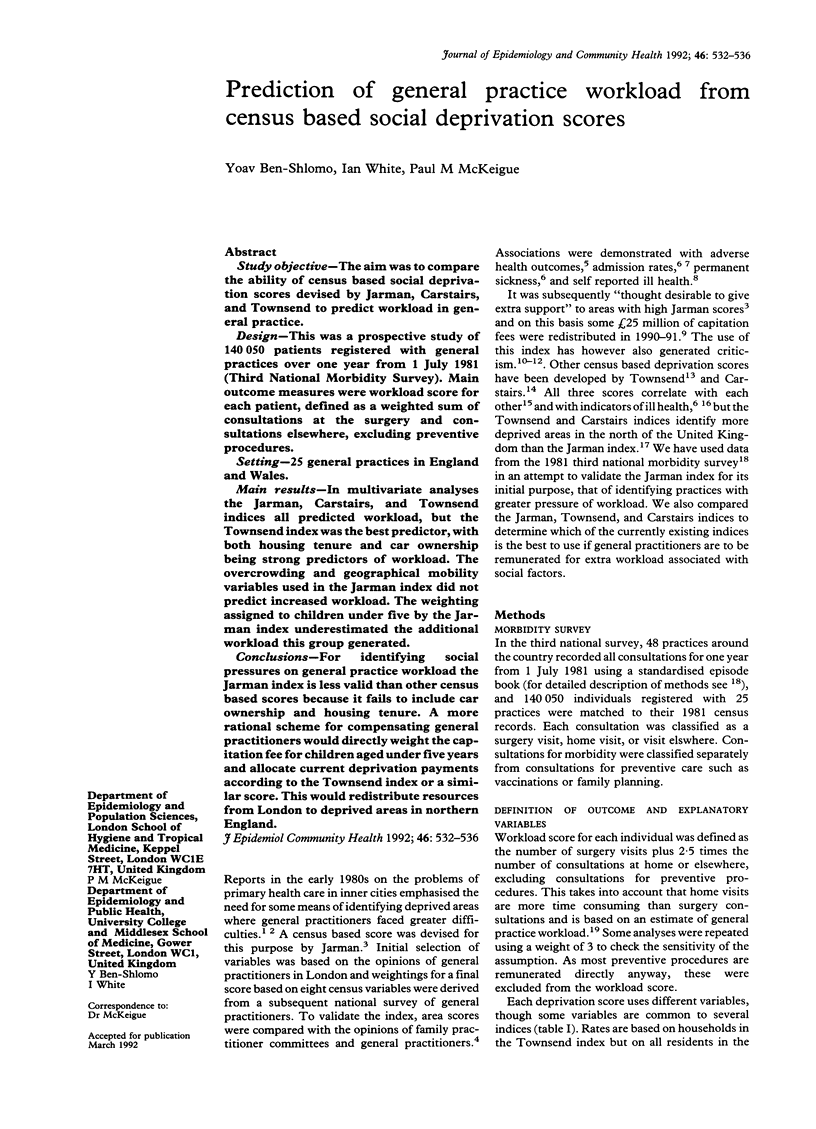Abstract
STUDY OBJECTIVE--The aim was to compare the ability of census based social deprivation scores devised by Jarman, Carstairs, and Townsend to predict workload in general practice. DESIGN--This was a prospective study of 140,050 patients registered with general practices over one year from 1 July 1981 (Third National Morbidity Survey). Main outcome measures were workload score for each patient, defined as a weighted sum of consultations at the surgery and consultations elsewhere, excluding preventive procedures. SETTING--25 general practices in England and Wales. MAIN RESULTS--In multivariate analyses the Jarman, Carstairs, and Townsend indices all predicted workload, but the Townsend index was the best predictor, with both housing tenure and car ownership being strong predictors of workload. The overcrowding and geographical mobility variables used in the Jarman index did not predict increased workload. The weighting assigned to children under five by the Jarman index underestimated the additional workload this group generated. CONCLUSIONS--For identifying social pressures on general practice workload the Jarman index is less valid than other census based scores because it fails to include car ownership and housing tenure. A more rational scheme for compensating general practitioners would directly weight the capitation fee for children aged under five years and allocate current deprivation payments according to the Townsend index or a similar score. This would redistribute resources from London to deprived areas in northern England.
Full text
PDF




Selected References
These references are in PubMed. This may not be the complete list of references from this article.
- Bland J. M., Altman D. G. Statistical methods for assessing agreement between two methods of clinical measurement. Lancet. 1986 Feb 8;1(8476):307–310. [PubMed] [Google Scholar]
- Campbell D. A., Radford J. M., Burton P. Unemployment rates: an alternative to the Jarman index? BMJ. 1991 Sep 28;303(6805):750–755. doi: 10.1136/bmj.303.6805.750. [DOI] [PMC free article] [PubMed] [Google Scholar]
- Carr-Hill R. A., Sheldon T. Designing a deprivation payment for general practitioners: the UPA(8) wonderland. BMJ. 1991 Feb 16;302(6773):393–396. doi: 10.1136/bmj.302.6773.393. [DOI] [PMC free article] [PubMed] [Google Scholar]
- Carstairs V., Morris R. Deprivation and health. BMJ. 1989 Dec 9;299(6713):1462–1462. doi: 10.1136/bmj.299.6713.1462-a. [DOI] [PMC free article] [PubMed] [Google Scholar]
- Carstairs V., Morris R. Deprivation and mortality: an alternative to social class? Community Med. 1989 Aug;11(3):210–219. doi: 10.1093/oxfordjournals.pubmed.a042469. [DOI] [PubMed] [Google Scholar]
- Charlton J. R., Lakhani A. Is the Jarman underprivileged area score valid? Br Med J (Clin Res Ed) 1985 Jun 8;290(6483):1714–1716. doi: 10.1136/bmj.290.6483.1714. [DOI] [PMC free article] [PubMed] [Google Scholar]
- Curtis S. E. Use of survey data and small area statistics to assess the link between individual morbidity and neighbourhood deprivation. J Epidemiol Community Health. 1990 Mar;44(1):62–68. doi: 10.1136/jech.44.1.62. [DOI] [PMC free article] [PubMed] [Google Scholar]
- Haan M., Kaplan G. A., Camacho T. Poverty and health. Prospective evidence from the Alameda County Study. Am J Epidemiol. 1987 Jun;125(6):989–998. doi: 10.1093/oxfordjournals.aje.a114637. [DOI] [PubMed] [Google Scholar]
- Humphreys K., Carr-Hill R. Area variations in health outcomes: artefact or ecology. Int J Epidemiol. 1991 Mar;20(1):251–258. doi: 10.1093/ije/20.1.251. [DOI] [PubMed] [Google Scholar]
- Hutchinson A., Foy C., Sandhu B. Comparison of two scores for allocating resources to doctors in deprived areas. BMJ. 1989 Nov 4;299(6708):1142–1144. doi: 10.1136/bmj.299.6708.1142. [DOI] [PMC free article] [PubMed] [Google Scholar]
- Jarman B. Identification of underprivileged areas. Br Med J (Clin Res Ed) 1983 May 28;286(6379):1705–1709. doi: 10.1136/bmj.286.6379.1705. [DOI] [PMC free article] [PubMed] [Google Scholar]
- Jarman B., Townsend P., Carstairs V. Deprivation indices. BMJ. 1991 Aug 31;303(6801):523–523. doi: 10.1136/bmj.303.6801.523-a. [DOI] [PMC free article] [PubMed] [Google Scholar]
- Jarman B. Underprivileged areas: validation and distribution of scores. Br Med J (Clin Res Ed) 1984 Dec 8;289(6458):1587–1592. doi: 10.1136/bmj.289.6458.1587. [DOI] [PMC free article] [PubMed] [Google Scholar]
- Mays N., Chinn S. Relation between all cause standardised mortality ratios and two indices of deprivation at regional and district level in England. J Epidemiol Community Health. 1989 Jun;43(2):191–199. doi: 10.1136/jech.43.2.191. [DOI] [PMC free article] [PubMed] [Google Scholar]
- Pocock S. J., Ashby D., Smith M. A. Lead exposure and children's intellectual performance. Int J Epidemiol. 1987 Mar;16(1):57–67. doi: 10.1093/ije/16.1.57. [DOI] [PubMed] [Google Scholar]
- Radford J., Campbell D. Deprivation indices. BMJ. 1991 Oct 5;303(6806):857–857. doi: 10.1136/bmj.303.6806.857. [DOI] [PMC free article] [PubMed] [Google Scholar]
- Scott-Samuel A. Need for primary health care: an objective indicator. Br Med J (Clin Res Ed) 1984 Feb 11;288(6415):457–458. doi: 10.1136/bmj.288.6415.457. [DOI] [PMC free article] [PubMed] [Google Scholar]
- Smith G. D. Second thoughts on the Jarman index. BMJ. 1991 Feb 16;302(6773):359–360. doi: 10.1136/bmj.302.6773.359. [DOI] [PMC free article] [PubMed] [Google Scholar]
- Talbot R. J. Underprivileged areas and health care planning: implications of use of Jarman indicators of urban deprivation. BMJ. 1991 Feb 16;302(6773):383–386. doi: 10.1136/bmj.302.6773.383. [DOI] [PMC free article] [PubMed] [Google Scholar]
- Thornicroft G. Social deprivation and rates of treated mental disorder. Developing statistical models to predict psychiatric service utilisation. Br J Psychiatry. 1991 Apr;158:475–484. doi: 10.1192/bjp.158.4.475. [DOI] [PubMed] [Google Scholar]


